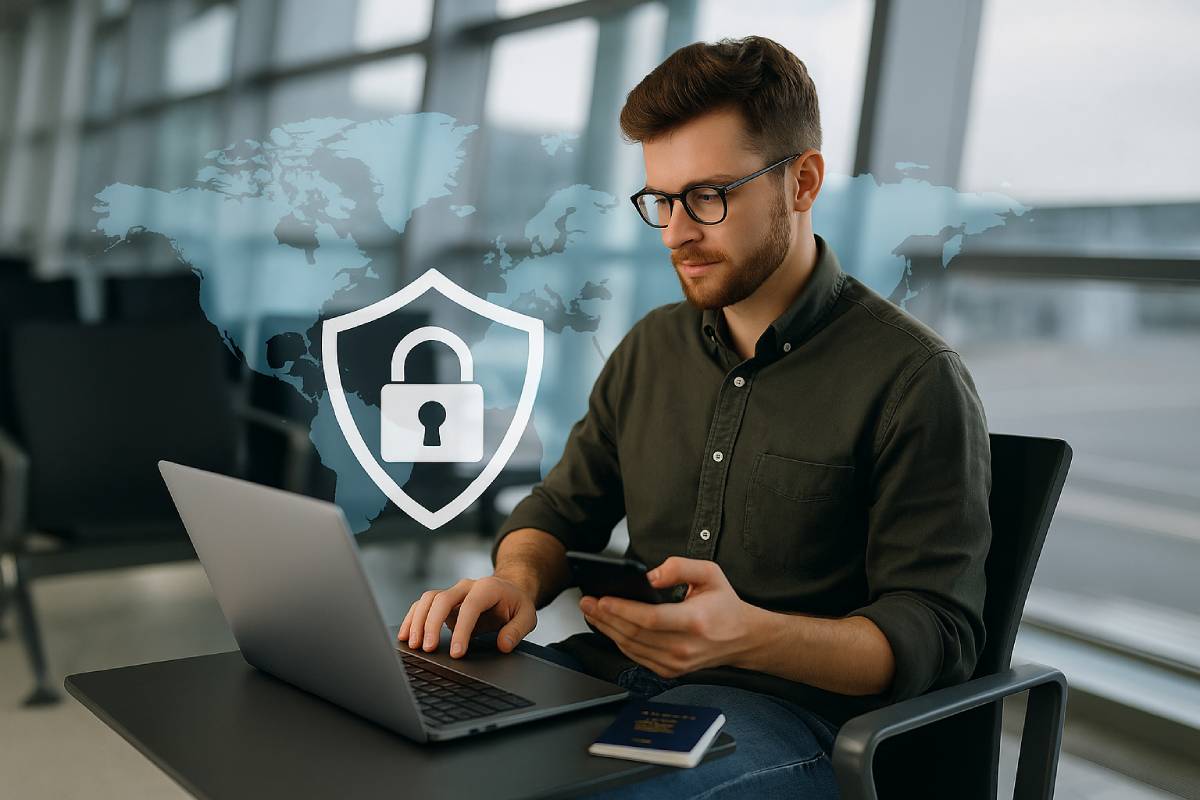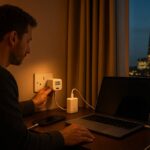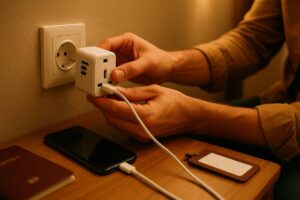As travel becomes more connected, cybercriminals increasingly target unsuspecting globetrotters with sophisticated phishing schemes, malware-laden public Wi-Fi hotspots, and even USB “juice-jacking” stations at airports, all designed to steal your personal and financial data.
Recent studies reveal that roughly 20% of travelers fall victim to some form of cybercrime abroad, from stolen credentials to ransomware attacks.
To stay one step ahead, embrace a simple “before/during/after” security plan—lock down and back up your devices before you leave, use VPNs and smart habits on the road, then audit and restore your data once you’re safely home.
Pre-Travel Preparations

Inventory & Backup Checklist
- Device & Data Inventory
- List every device (laptop, smartphone, tablet) along with OS versions and critical apps.
- Note cloud services in use (e.g., Google Drive, iCloud) and locally stored sensitive folders.
- Create Local & Cloud Backups
- Laptop: Use Time Machine (macOS) or File History (Windows) plus an encrypted cloud service.
- Phone: Enable automatic backups to Google Drive (Android) or iCloud (iOS).
- External SSD/Drive: Mirror essential folders and test decryption passphrase.
- Verify Restoration Procedures
- Perform a trial restore of one file from each backup destination to confirm integrity.
- Document and save restore steps offline (printed or PDF on a secure USB).
| Device | Description | Backup Method |
|---|---|---|
| Laptop | Windows 11, Office docs | Local SSD clone & OneDrive encrypted |
| Smartphone | Android 13, banking & email | Google Drive auto-backup |
| External SSD | Photos & project archives | Encrypted mirror + Dropbox offsite |
Secure Account Setup
- Password Management: Adopt a reputable manager like 1Password (Travel Mode feature) or Bitwarden for strong, unique credentials and cross-device sync.
- Two-Factor Authentication (2FA): Enable on email, banking, and social accounts using an authenticator app (Google Authenticator, Authy) rather than SMS to thwart SIM-swap attacks.
- Account Recovery: Update recovery emails/phone numbers and securely record recovery codes offline (print or encrypted note) so you can regain access if locked out abroad.
VPN & Network Safety
- Choose a Trusted VPN: Look for a strict no-logs policy, AES-256 encryption, RAM-only servers, and global server coverage outside surveillance alliances (e.g., ExpressVPN, NordVPN).
- Pre-Install & Test: Download and configure your VPN client at home. Verify you can connect to multiple locations and that streaming or banking sites still work behind the VPN.
- Configure Kill Switch & Auto-Connect: Activate the kill switch to block all traffic if the VPN drops, and enable auto-connect on untrusted networks to avoid accidental exposure.
Device Hardening
- Operating System & App Updates: Install the latest OS patches and app updates before departure; turn on automatic updates wherever possible to remediate vulnerabilities.
- Full-Disk Encryption:
- Windows: Enable BitLocker.
- macOS: Enable FileVault.
- Mobile: Use built-in device encryption (PIN/biometric + encrypted storage.
- Anti-Malware & Firewall: Install a reputable endpoint solution (e.g., Kaspersky Internet Security) and ensure your OS firewall is active to block unauthorized inbound connections.
By systematically completing these Pre-Travel Preparations, you’ll establish a resilient foundation, ensuring that even if a device is lost, stolen, or targeted by cybercriminals, your data remains secure and recoverable.
Security During Travel
Travelers on the go face a multitude of digital threats—from malicious Wi-Fi networks to opportunistic thieves—so it’s critical to employ layered defenses that lock down both your online and physical presence. By routing all traffic through a VPN, disabling auto-join, and verifying SSIDs, you can keep your connections private.
Reinforcing device locks, using privacy screens, and carrying devices with you at all times deters physical theft. Disabling geotagging and tightening social media settings shields your location data. Finally, staying alert to phishing schemes, such as fake hotel captive portals, and establishing a lost-and-stolen protocol (remote wipe, device tracking) rounds out a travel-ready security posture.
Public Wi-Fi Protocols
- Always route through VPN—even for “trusted” networks. VPN encryption hides your traffic from local eavesdroppers and malicious hotspots.
- Disable auto-join; verify network SSID with staff. Prevent accidental connections to evil-twin networks by turning off auto-connect and confirming the correct SSID at reception.
- Avoid sensitive transactions on public Wi-Fi; use mobile tethering for critical tasks. Reserve banking, email access, and file transfers for cellular data or personal hotspots.
Physical Device Security
- Use privacy screens and cable locks for laptops. Privacy filters thwart shoulder surfers; a sturdy cable lock anchors your device to fixed objects.
- Never leave devices unattended; keep them in a carry-on. Laptops and phones should remain on your person or locked in your bag—checked baggage is an open invitation for theft.
- Consider RFID-blocking sleeves for passports and cards. Slim RFID sleeves block unauthorized scans of passports and credit cards in crowded terminals.
Social Media & Location Privacy
- Geo-tagging Off: Disable automatic location tags on photos to prevent revealing your exact whereabouts.
- Strict Privacy Settings: Review and restrict who can view your posts; set accounts to “friends only” or custom lists.
- Delayed Posting: Share vacation highlights after you return home to avoid signaling an unoccupied property.
Threat Awareness & Response
- Recognize phishing attempts via fake hotel Wi-Fi login pages or SMS. Watch for generic “login” forms, unexpected requests for personal info, and URLs that don’t match the hotel’s domain.
- Use browser-based sandboxing (e.g., Chrome’s Guest mode) for unknown sites. Sandboxed sessions isolate untrusted pages, preventing persistent malware infections.
- Have a “lost/stolen” protocol: enable remote wipe, device tracking, and keep emergency contact numbers handy so you can act immediately if a device goes missing.
| Area | Best Practice Overview |
|---|---|
| Public Wi-Fi Protocols | Privacy screens, cable locks, carry-on only; RFID sleeves |
| Physical Device Security | VPN always, disable auto-join, verify SSID, switch to mobile data |
| Social Media Privacy | Privacy screens, cable locks, carry-on only, RFID sleeves |
| Threat Awareness & Response | Spot phishing portals; sandbox browsing, have a remote-wipe plan |
This layered approach ensures your data and devices remain protected from cyber threats and physical risks alike, letting you focus on the journey ahead rather than worrying about what could go wrong.
After You Return
After your trip, a swift and systematic follow-up is crucial: start by verifying that your backups are intact—only 57 % of backups succeed, and just 61 % of restores meet expectations—so use checksums or hash functions and full-system images to confirm file integrity.
Next, rotate passwords and review account logs: strong password management can cut breach risk by 30–50 %, while poor password hygiene underlies 81 % of all data breaches.
Regularly audit login activity to detect anomalies early—organizations currently take an average of 204 days to identify breaches, and 96 % of incidents slip by without systematic monitoring.
Finally, if you suspect any compromise, notify banks, email providers, or your employer’s IT team immediately—bank service providers are required to alert designated contacts “as soon as possible” after a material incident, and under GDPR, you must report personal data breaches within 72 hours.
Data Integrity & Recovery
Restoring & Verifying Backups
- Use full-system image restores to recover operating systems and applications, not just individual files.
- Verify backup file integrity with checksums or hash functions before relying on restores.
- Follow the 3-2-1 rule: keep three copies of data on two different media, with one offsite, to prevent single-point failures.
- Plan for periodic recovery tests; 39 % of IT decision-makers find themselves restoring from backups at least monthly, so regular drills are essential.
Secure Cleanup
Begin by removing any leftover network profiles and VPN configurations to prevent accidental reconnection to malicious hotspots. Clear known Wi-Fi networks on Windows via Settings > Network & Internet > Wi-Fi > Manage known networks and “Forget” each profile.
On macOS, go to System Settings > Wi-Fi > Details next to each network and click Forget This Network. Likewise, delete your VPN profiles or disable auto-connect in the VPN client to avoid unintended exposure.
Security Audit
Password Rotation
- Implement a password-rotation schedule for high-value accounts every 30–90 days.
- Strong password policies and rotation practices can reduce breach risk by 30–50 %.
- Remember, 81 % of breaches exploit stolen or weak credentials—rotation limits the window of exposure.
Review Account Activity
- Examine login logs and security alerts on banking, email, and cloud accounts.
- Proactive log review is vital: organizations now take 204 days on average to spot breaches—reduce this lag with regular audits.
- Systematic monitoring is often missing: 96 % of breaches go unnoticed without proper log analysis.
Incident Reporting
Compromise Response
- If you detect unauthorized access or data loss, notify your bank’s fraud department, your email provider’s security team, and, if traveling on work equipment, your employer’s IT security immediately.
- U.S. bank service providers must alert designated contacts “as soon as possible” after a material computer-security incident.
- In the E.U., GDPR mandates that organizations report personal data breaches to authorities within 72 hours of discovery to avoid heavy fines.
Tailored Advice for Traveler Profiles
Business travelers rely on secure VPN connections to access internal systems: 73 % of companies mandate VPN use for remote access, and 31 % of professionals connect to VPNs daily to protect confidential data.
Digital nomads benefit from portable routers paired with a home-based VPN and mesh-network kits that auto-update firmware, ensuring seamless, encrypted coverage in co-working spaces and cafés.
Leisure travelers can pack intuitive safety gear—anti-theft backpacks, personal alarms, and RFID-blocking passport covers—to deter pickpockets, gadgets endorsed by Travel + Leisure editors and Under30Experiences guides.
First-time international flyers should follow the U.S. Department of State’s five-step traveler checklist and sanitize devices before border crossings, then use a stripped-down travel phone to meet inspection policies (travel.state.gov).
Business Travelers
- Corporate VPNs & Secure Remote Access
Leverage your company’s sanctioned VPN client to encrypt all traffic and access intranet resources safely. With 73 % of organizations requiring VPN use, you’ll meet compliance standards and reduce the risk of data leaks on hotel or airport networks. - Zero-Trust & Conditional Access
Use multi-factor authentication (MFA) and conditional-access policies—for example, device-compliance checks—to ensure only authorized devices connect to corporate apps.
Digital Nomads
- Portable Routers + Home VPN
Carry a compact travel router (e.g., GL.iNet Beryl AX) that tunnels traffic back to your home VPN, bypassing local hotspot risks and geo-restrictions. - Mesh Networks for Larger Teams
Deploy a small mesh-WiFi system (e.g., Google Nest Wi-Fi, Gryphon) in longer-stay rentals to auto-patch security flaws and extend coverage without exposing devices to public SSIDs.
Leisure Travelers
- Anti-Theft & Privacy Gear
Pack an anti-theft backpack with lockable zippers, a personal safety alarm, and RFID-blocking passport covers to guard against opportunistic theft—items recommended by Travel + Leisure and Under30Experiences. - Simple Digital Hygiene
Disable auto-join for open Wi-Fi networks, enable credit-card transaction alerts, and use an easy password manager (like LastPass or 1Password) with Travel Mode for critical logins only.
First-Time International Flyers
- Five-Step Government Checklist
Follow the U.S. Department of State’s official “International Traveler’s Checklist” to register your trip, backup data, and enroll in emergency-alert programs before departure. - Border Inspection Prep
To avoid delays at U.S. or EU borders, carry a sanitized “travel phone” with minimal data, disable biometrics in favor of PINs, and uninstall non-essential apps—strategies endorsed by privacy experts in Wired (wired.com).
| Traveler Profile | Recommended Tools & Practices | Key Benefit / Stat |
|---|---|---|
| Business Travelers | Corporate VPN + MFA + Conditional Access | 73 % of companies mandate VPN; 31 % daily use |
| Digital Nomads | Portable Router → Home VPN; Mesh-WiFi systems | Secure, self-managed encrypted network |
| Leisure Travelers | State Dept. 5-step checklist: travel phone prep | Editor-recommended safety gear |
| First-Time Flyers | State Dept. 5-step checklist; travel phone prep | Official guidance + border inspection hygiene |
Additional Considerations
Below is a concise overview of key additional considerations to solidify your travel security strategy, from complying with global privacy laws to choosing the right tools and adapting to device-specific risks.

Ensuring compliance with regulations like GDPR and CCPA helps you avoid legal pitfalls when handling personal data across borders. Tailoring protections to each device—whether mobile, laptop, or IoT wearable—addresses unique vulnerabilities, such as power-bank fire risks or smartwatch data theft.
Finally, investing in industry-leading VPNs, password managers, and mobile security apps ensures a practical defense that’s easy to implement on the go.
International Data Protection Laws
GDPR (EU): Applies to any organization processing personal data of EU residents, regardless of where the organization is based. Key requirements include data minimization, explicit consent, breach notification within 72 hours, and hefty fines (up to €20 million or 4% of global turnover) for non-compliance.
CCPA (California): Grants California consumers the right to know, delete, and opt out of the sale of their personal data. Businesses must provide “Do Not Sell My Personal Information” links and risk fines up to $7,500 per intentional violation.
Other Major Regimes: Many countries—from Brazil’s LGPD to South Korea’s PIPA—mirror GDPR’s core principles but differ on consent rules and enforcement mechanisms.
| Regulation | Territory | Key Rights & Obligations | Penalties |
|---|---|---|---|
| GDPR | EU | Consent, data portability, breach notification in 72 hrs | Up to €20 M or 4% of global revenue |
| CCPA | California, US | Right to know, delete, opt-out of sale | Up to $7,500 per intentional violation |
| LGPD | Brazil | Similar to GDPR, with an additional data officer requirement | Similar to GDPR, with additional data officer requirement |
Cross-Border Data Transfers: Under GDPR, transfers outside the EU require adequacy decisions (e.g., UK, Japan) or Standard Contractual Clauses.CCPA has no specific transfer rules, but businesses must still protect consumer rights post-transfer.
Device-Specific Tips
- Mobile vs. Laptop:
- Power-bank Safety: Always choose TSA-compliant models clearly labeled with watt-hour ratings and pack in carry-on only to avoid fire risks.
- SD Card Encryption: Use built-in encryption tools (e.g., BitLocker To Go, VeraCrypt) to protect photos and documents stored on removable media.
- App-Level VPN: Configure critical apps (banking, email) to use per-app VPN features (available in iOS 15+ and Android 12+) for granular protection.
- IoT & Wearables:
- Smartwatches: Risk of Bluetooth exploits and data theft—enable device PIN/biometric locks and install firmware updates promptly.
- Connected Luggage: GPS trackers can leak location data; choose models with encrypted communication channels and disable tracking when not needed.
Recommended Tools & Resources
Top VPN Providers: A secure VPN encrypts all traffic, masks your IP, and prevents ISP or hotspot snooping.
Trusted Password Managers:
- 1Password: Travel Mode lets you remove sensitive vaults from devices and restore them later.
- Bitwarden: Open-source, end-to-end encrypted, free tier available.
- Dashlane: Includes dark-web monitoring and VPN bundle options.
Mobile Security Apps:
- Lookout Mobile Security: Anti-phishing, Wi-Fi scanning, and theft protection.
- Avast Mobile Security: Malware scanning, app-lock, and VPN integration.
- McAfee Mobile Security: Secure media vault, anti-theft, and safe web browser.
By understanding global privacy laws, tailoring security to each device, and leveraging best-in-class tools, you’ll fortify your digital defenses and travel with confidence, no matter where your passport takes you.
Before you head off on your next journey, taking action is the key to turning knowledge into protection. A clear, downloadable security checklist can boost compliance. Travel-and-hospitality landing pages convert at a median of 4.8% when paired with compelling assets.
Downloadable Security Checklist
Offer travelers a comprehensive PDF or interactive guide they can print or save to their devices. A well-designed checklist covering pre-, during-, and post-travel security steps encourages downloads and repeat reference, key for on-the-go use.
- Placement: Prominent button above the fold and at the end of your article.
- Copy Example: “Download Your Free Travel Security Checklist (PDF)”
- Expected Conversion: Aim for ≥4.8% download rate, matching travel landing page benchmarks.
Conclusion
Once you’re back home, remember that digital security doesn’t end at customs clearance. Clearing old Wi-Fi profiles, reviewing device logs, and rotating critical passwords will close any gaps uncovered on the road.
By embedding these practices into your routine—updating your travel security checklist, sharing insights with fellow explorers, and leveraging trusted tools like VPNs and password managers—you’ll transform travel from a cyber-risk into a stress-free experience, ensuring your data stays in your hands and off the radar of cybercriminals.
FAQs
What’s the single most important step to secure data on public Wi-Fi?
Always route your connection through a reputable VPN to encrypt traffic and block local eavesdroppers.
How often should I back up my devices before a trip?
Perform fresh backups within 24 hours of departure—both locally (external SSD) and to the cloud—to capture your latest files and settings.
Can I rely on SMS-based 2FA when traveling internationally?
No, SMS codes are vulnerable to SIM-swap attacks. Use an authenticator app (e.g., Authy, Google Authenticator) or hardware key (YubiKey) instead.
What physical security measures matter most in airports?
Use privacy screens, cable locks, and always keep devices in your carry-on. Consider RFID-blocking sleeves for passports and cards.
Which data-protection laws apply when crossing borders?
GDPR covers EU residents, CCPA protects Californians; for other regions (LGPD in Brazil, PIPA in South Korea), follow local consent and breach-notification rules.





















